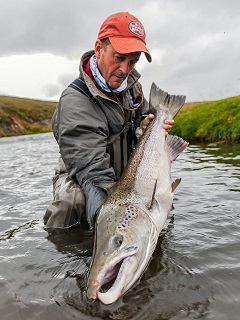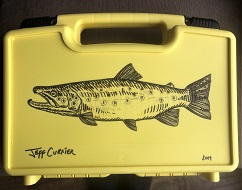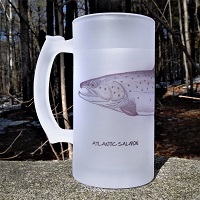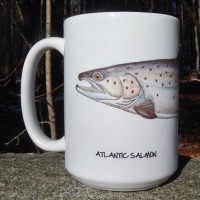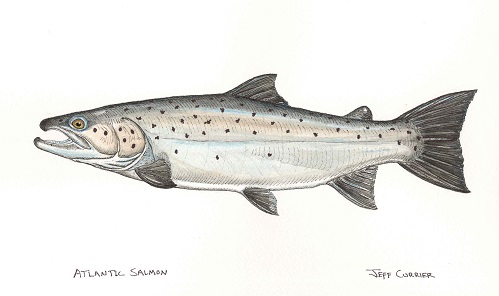 (Salmo salar)
(Salmo salar)
Description
The Atlantic salmon is a member of the family Salmonidae. They are considered on of the top game fish in the world. Most Atlantic salmon are anadromous spending the majority of the growing life in salt water and returning to freshwater to spawn. However, Atlantic salmon do not need salt water to survive and there are populations that live entirely in fresh water. The fresh water Atlantics are called landlocked salmon. It should be noted also that unlike Pacific salmon species, Atlantic salmon usually return to the ocean after spawning and repeat the cycle as many as four times.
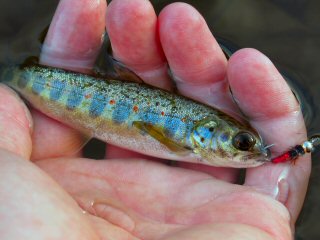 Size
Size
You might first catch Atlantic salmon in their parr stage in the rivers where they hatched. As parr they are aggressive little guys building up strength and size getting ready for the Atlantic Ocean. Next they become smolt and make their move to the ocean. Once to the 4-6lb range, Atlantic salmon become grilse and are ready to return to fresh water. The length of time this takes varies depending on the fish and location but is between one and four years.
Although they get much larger, once Atlantic salmon exceed 10lbs they are considered magnificent game fish. What’s considered big varies based on location. Norway is famous for true monsters and I met one on the famous Orkla River there in 2010 but I lost him.
My Largest So Far
In Iceland, where I’ve had the most success, Atlantic salmon average 10-14lbs. I caught a 96 cm salmon with a 49 cm girth that weighed nearly 10 kilos (almost 22lb) on the Laxá í Ađaldal with my friend Ingolfur Helgason of Icelandic Fly Fishermen in 2014. That’s a great salmon in Iceland!
Distribution
Atlantic salmon are natives to the North Atlantic Ocean and rivers that flow i1n to the North Atlantic Ocean. They are found throughout coastal Europe as far south as Spain and the east coast of North America. I haven’t been Atlantic salmon fishing much but my best trips have been to Iceland in 2014 and 2016.
Habits
 Atlantic Salmon enter rivers to spawn from early summer to early fall. When around they can be seen free jumping and rolling. It’s suggested that the Atlantics are not feeding while in the rivers but react to flies in aggression and therefore have become such incredible fly rod game fish. They are remarkably powerful and hold in tremendously strong current. They can leap incredibly high and hurdle themselves up waterfalls that no other fish could. They love to hang in the tail outs of deep pools rather than the deep pool itself.
Atlantic Salmon enter rivers to spawn from early summer to early fall. When around they can be seen free jumping and rolling. It’s suggested that the Atlantics are not feeding while in the rivers but react to flies in aggression and therefore have become such incredible fly rod game fish. They are remarkably powerful and hold in tremendously strong current. They can leap incredibly high and hurdle themselves up waterfalls that no other fish could. They love to hang in the tail outs of deep pools rather than the deep pool itself.
Personal Experience
I grew up in the 70’s dreaming of catching an Atlantic salmon. Dad and I tried a few times, mostly in Maine, but those days most populations were wiped out. Fortunately I caught many landlocked salmon from Lake Winnipesaukee after ice out each year.
 Due to the diminishing Atlantic salmon populations, not only in North America but throughout the world, catching an Atlantic salmon seemed unlikely. There are places where they still thrive but to fish these places is beyond expensive. I wrote the species off thinking a fishing bum like me would never get the chance at one. Little did I know opportunities would come my way.
Due to the diminishing Atlantic salmon populations, not only in North America but throughout the world, catching an Atlantic salmon seemed unlikely. There are places where they still thrive but to fish these places is beyond expensive. I wrote the species off thinking a fishing bum like me would never get the chance at one. Little did I know opportunities would come my way.
My first big time Atlantic salmon experience was on the Tweed River in Scotland in 2000. My dad was with and we were guests of Hardy. Our host that day was professional spey caster, Andy Murray. Andy introduced us to spey fishing but neither of us caught a salmon. I took a step closer to the dream however; a nice salmon free jumped next to my fly but that was all I saw of him.
 That salmon that leaped by my fly in Scotland lit the fire, I had to catch and Atlantic salmon at some point in my life. In 2010 my great friend from Poland, Vladi Trzebunia, invited me to join him in Norway. Norway is one of the most expensive places in the world to chase Atlantic salmon but Vladi was an Atlantic salmon guide in Norway during the 80’s. He had connections and wanted to return and visit his friends. It was a wonderful cultural experience for me in which I got ten days of fishing on the famous Gaula River and the Orkla.
That salmon that leaped by my fly in Scotland lit the fire, I had to catch and Atlantic salmon at some point in my life. In 2010 my great friend from Poland, Vladi Trzebunia, invited me to join him in Norway. Norway is one of the most expensive places in the world to chase Atlantic salmon but Vladi was an Atlantic salmon guide in Norway during the 80’s. He had connections and wanted to return and visit his friends. It was a wonderful cultural experience for me in which I got ten days of fishing on the famous Gaula River and the Orkla.
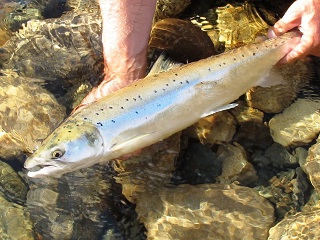
The Norway trip was a great experience but not great fishing. I landed only two grilse along with some sea trout. I watched several nice salmon caught so I knew they were there, but I was too much of a rookie. I know for a fact I missed some touches on the swing. I read the water poorly (Atlantics live in different places than trout). And worst of all, when I was so exhausted to the point where I couldn’t function thanks to the midnight sun and an accumulation of twenty hour days, I had the Atlantic salmon of a lifetime devour my fly on the Orkla and I set too soon and lost him just as he took off.
At least in Norway I landed the species. The trip was great but the swinging of flies with little luck over ten days (again, twenty hour days due to the midnight sun) was agonizing and I told myself I was unlikely to ever fish for Atlantic’s again. That was until I met Ingo Helgason, at the time the owner of Icelandic Fly Fishermen.
 I first met Ingo at the Somerset, New Jersey Fly Fishing Show in 2012. It’s a long fun story but the short version is we got to be friends and in 2014 I went over to Iceland to visit Ingo and fished the Laxá í Ađaldal and the Flekkadalsá.
I first met Ingo at the Somerset, New Jersey Fly Fishing Show in 2012. It’s a long fun story but the short version is we got to be friends and in 2014 I went over to Iceland to visit Ingo and fished the Laxá í Ađaldal and the Flekkadalsá.
Ingo grew up fly fishing for Atlantic salmon and stood by my side and on my first day I learned a ton about reading water, swing angles and fly choices. Throughout my visit I made many adjustments and things started to click. I’d go on that week to landing some very nice Atlantics including the 96 cm beast!
 In 2016 I returned to fish with Ingo and another Icelandic friend Sigurour Heoinn (Siggy). This trip was special because I brought my wife and I couldn’t wait to see if she could land one. She struggled like I did on my first Atlantic trips but she never quit. On nearly the last day she landed this dandy from the Hofsá River.
In 2016 I returned to fish with Ingo and another Icelandic friend Sigurour Heoinn (Siggy). This trip was special because I brought my wife and I couldn’t wait to see if she could land one. She struggled like I did on my first Atlantic trips but she never quit. On nearly the last day she landed this dandy from the Hofsá River.
Fly Fishing Tactics for Atlantic Salmon
I’m not going deep into the tactics for Atlantic salmon because I’m far from an expert. But I’ve proven to myself that I’m a lot better at fishing for them now that I’m well trained by Ingo, Siggy and I certainly learned a lot my first times out with Vladi in Norway and Andy in Scotland.
 A huge part of Atlantic salmon fishing is reading water. They aren’t trout and don’t hide much under structures and often stay clear of the bank. Expect to find Atlantic’s in mid river, tail outs and on the upstream sides of rocks. While they often seek out a softer spot in the current, don’t be afraid to fish the heavy water as well. Fish that can leap over ten foot high waterfalls can certainly hold in strong current.
A huge part of Atlantic salmon fishing is reading water. They aren’t trout and don’t hide much under structures and often stay clear of the bank. Expect to find Atlantic’s in mid river, tail outs and on the upstream sides of rocks. While they often seek out a softer spot in the current, don’t be afraid to fish the heavy water as well. Fish that can leap over ten foot high waterfalls can certainly hold in strong current.
Have salmon flies that are recommended for the area you’re fishing. Then have a few of your favorites. There’s a ton of theories as to why Atlantic salmon take a fly but most experienced anglers don’t think they eat because they are hungry, but rather react to flies in aggression. I purposely carry a few brightly colored ones feeling that such colors might be likely to entice a stubborn salmon. This being said, the monster I caught in Iceland in 2014 fell for a small size 12 dull colored Laxá Ađaldal fly called the “Sally” from Ingo’s box.
 Flies should be swung not stripped. Fishing is all done with a floating line. I was taught to work above where I believe the fish are and cast across and slightly angled downstream. Once my cast lands I do a big upstream mend then begin my swing. Make sure you have a tightish line when your fly is in the zone so you can feel in case you get a strike. I was taught to be especially ready when your fly travels through a glassy spot. Watch for a wave or push of the salmon. When the swing is over and my fly is dangling straight below me I’ll let it sit for at least ten seconds. If I’m feeling confident that a fish has eyes on it, then I may strip it or twitch it.
Flies should be swung not stripped. Fishing is all done with a floating line. I was taught to work above where I believe the fish are and cast across and slightly angled downstream. Once my cast lands I do a big upstream mend then begin my swing. Make sure you have a tightish line when your fly is in the zone so you can feel in case you get a strike. I was taught to be especially ready when your fly travels through a glassy spot. Watch for a wave or push of the salmon. When the swing is over and my fly is dangling straight below me I’ll let it sit for at least ten seconds. If I’m feeling confident that a fish has eyes on it, then I may strip it or twitch it.
 There’s a trick to setting the hook on an Atlantic salmon. For most fish, as soon as they eat our fly we set with either an uplift of our rod or strip set. With salmon, these methods usually pull the fly from the fish. Instead, when you feel the pull let them take a couple feet of line so that they are turned away. Then you can strip set and lift the rod. The idea is that you catch them in the corner of the mouth.
There’s a trick to setting the hook on an Atlantic salmon. For most fish, as soon as they eat our fly we set with either an uplift of our rod or strip set. With salmon, these methods usually pull the fly from the fish. Instead, when you feel the pull let them take a couple feet of line so that they are turned away. Then you can strip set and lift the rod. The idea is that you catch them in the corner of the mouth.
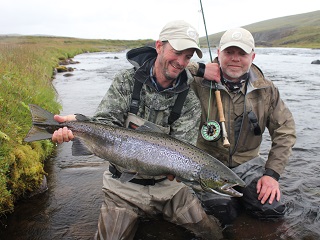
Once you hook up let your Atlantic salmon run. Many experienced anglers consider this salmon to be one of the hardest fighting of all freshwater fish. Expect numerous jumps and a long run. Take your time and be sure to have a net.
Once again, being I’m far from an expert on Atlantic salmon fishing, I’m not going to get into great detail of techniques. My best advice – get a guide!
Equipment
I am “The Single Handed American” so this is what I use. Many Atlantic salmon anglers fish spey rods.
Rod: 9½-foot for an 8- or 9-weight line.
Reel: Atlantic’s pull hard and make long runs. A reel with a strong smooth drag is a must.
Line: 9-weight, weight forward floating, WF9F.
Leader: 9-foot for 10 to 16-pound tippet.
Flies: The best hook sizes are from 8 -2/0. Many anglers prefer tube flies. A few favorite patterns are the Sunray Shadow, Green Machine, Red Frances, Classic Willie Gun Double, Bomber and a Royal Wulf.
Jeff’s Atlantic Salmon Art
Get Jeff’s Atlantic salmon artwork on a variety of products by visiting his new and growing online store. Order one of his famous 15 oz coffee mugs a frosted beer mug a solar shirt a hoodie or a custom sharpie art Cliff Fly Box. You can even commission Jeff to paint the one you caught!

 (Salmo salar)
(Salmo salar)
